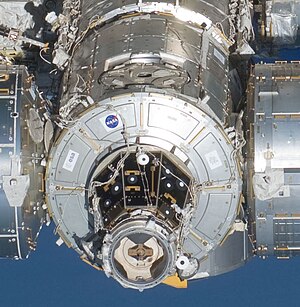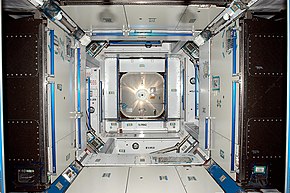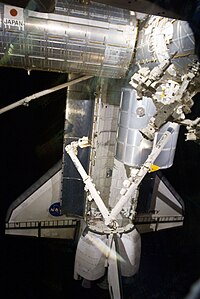
The International Space Station (ISS) is a large space station assembled and maintained in low Earth orbit by a collaboration of five space agencies and their contractors: NASA, Roscosmos (Russia), JAXA (Japan), ESA (Europe), and CSA (Canada). The ISS is the largest space station ever built. Its primary purpose is to perform microgravity and space environment experiments.

Space Shuttle Atlantis is a retired Space Shuttle orbiter vehicle which belongs to NASA, the spaceflight and space exploration agency of the United States. Atlantis was manufactured by the Rockwell International company in Southern California and was delivered to the Kennedy Space Center in Eastern Florida in April 1985. Atlantis is also the fourth operational and the second-to-last Space Shuttle built. Its maiden flight was STS-51-J made from October 3 to 7, 1985.

The Japanese Experiment Module (JEM), nicknamed Kibō, is a Japanese science module for the International Space Station (ISS) developed by JAXA. It is the largest single ISS module, and is attached to the Harmony module. The first two pieces of the module were launched on Space Shuttle missions STS-123 and STS-124. The third and final components were launched on STS-127.
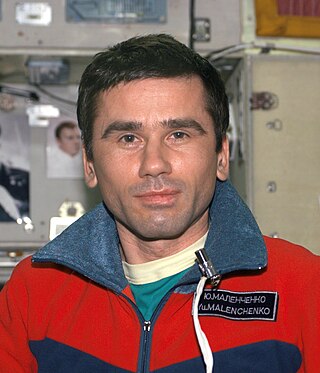
Yuri Ivanovich Malenchenko is a retired Russian cosmonaut. Malenchenko became the first person to marry in space, on 10 August 2003, when he married Ekaterina Dmitrieva, who was in Texas, while he was 240 miles (390 km) over New Zealand, on the International Space Station. As of December 2023, Malenchenko ranks third for career time in space due to his time on both Mir and the International Space Station (ISS). He is a former commander of the International Space Station.

STS-98 was a 2001 Space Shuttle mission to the International Space Station (ISS) flown by Space Shuttle Atlantis. It was the first human spaceflight launch of the 21st century. STS-98 delivered to the station the Destiny Laboratory Module. All mission objectives were completed and the shuttle reentered and landed safely at Edwards Air Force Base on 20 February 2001, after twelve days in space, six of which were spent docked to the ISS.

Zvezda, Salyut DOS-8, also known as the Zvezda Service Module, is a module of the International Space Station (ISS). It was the third module launched to the station, and provided all of the station's life support systems, some of which are supplemented in the US Orbital Segment (USOS), as well as living quarters for two crew members. It is the structural and functional center of the Russian Orbital Segment (ROS), which is the Russian part of the ISS. Crew assemble here to deal with emergencies on the station.

The Cupola is an ESA-built observatory module of the International Space Station (ISS). Its name derives from the Italian word cupola, which means "dome". Its seven windows are used to conduct experiments, dockings and observations of Earth. It was launched aboard Space Shuttle Endeavour's mission STS-130 on 8 February 2010, and attached to the Tranquility module. With the Cupola attached, ISS assembly reached 85 percent completion. The Cupola's central window has a diameter of 80 cm (31 in).

The Unity connecting module, also known as Node 1, is the first U.S.-built component of the International Space Station (ISS). It connects the Russian and United States segments of the station, and is where crew eat meals together.

The Destiny module, also known as the U.S. Lab, is the primary operating facility for U.S. research payloads aboard the International Space Station (ISS). It was berthed to the Unity module and activated over a period of five days in February, 2001. Destiny is NASA's first permanent operating orbital research station since Skylab was vacated in February 1974.

Tranquility, also known as Node 3, is a module of the International Space Station (ISS). It contains environmental control systems, life support systems, a toilet, exercise equipment, and an observation cupola.

Expedition 16 was the 16th expedition to the International Space Station (ISS). The first two crew members, Yuri Malenchenko and Peggy Whitson, launched on 10 October 2007, aboard Soyuz TMA-11, and were joined by spaceflight participant Sheikh Muszaphar Shukor, the first Malaysian in space.

A Pressurized Mating Adapter (PMA) is a spacecraft adapter used on the International Space Station (ISS) to convert a Common Berthing Mechanism (CBM) interface to an APAS-95 docking port. Three PMAs are connected to the US Orbital Segment of ISS. PMA-1 and PMA-2 were launched with the Unity module in 1998 aboard STS-88; PMA-3 was launched in 2000 aboard STS-92. PMA-1 permanently connects the Unity and Zarya modules. IDA adapters have been installed on PMA-2 and PMA-3 which convert them to IDSS docking ports.

Rassvet, also known as the Mini-Research Module 1 and formerly known as the Docking Cargo Module (DCM), is a component of the International Space Station (ISS). The module's design is similar to the Mir Docking Module launched on STS-74 in 1995. Rassvet is primarily used for cargo storage and as a docking port for visiting spacecraft. It was flown to the ISS aboard Space ShuttleAtlantis on the STS-132 mission on 14 May 2010, and was connected to the ISS on 18 May 2010. The hatch connecting Rassvet with the ISS was first opened on 20 May 2010. On 28 June 2010, the Soyuz TMA-19 spacecraft performed the first docking with the module.

The process of assembling the International Space Station (ISS) has been under way since the 1990s. Zarya, the first ISS module, was launched by a Proton rocket on 20 November 1998. The STS-88 Space Shuttle mission followed two weeks after Zarya was launched, bringing Unity, the first of three node modules, and connecting it to Zarya. This bare 2-module core of the ISS remained uncrewed for the next one and a half years, until in July 2000 the Russian module Zvezda was launched by a Proton rocket, allowing a maximum crew of three astronauts or cosmonauts to be on the ISS permanently.
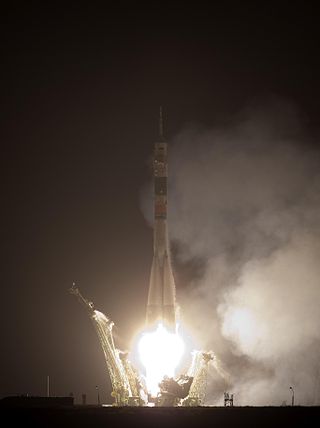
Soyuz TMA-17 was a human spaceflight mission to the International Space Station (ISS). TMA-17 crew members participated in ISS Expedition 22 and Expedition 23. The mission ended when the Soyuz TMA-17 capsule landed on 2 June 2010.

Kounotori 2, also known as HTV-2, was launched in January 2011 and was the second flight of the Japanese H-II Transfer Vehicle to resupply the International Space Station (ISS). It was launched by the H-IIB Launch Vehicle No. 2 manufactured by Mitsubishi Heavy Industries (MHI) and JAXA. After the supplies were unloaded, Kounotori 2 was loaded with waste material from ISS, including used experiment equipment and used clothes. Kounotori 2 was then unberthed and separated from the ISS and burned up upon reentering the atmosphere on 30 March 2011.

The Leonardo Permanent Multipurpose Module (PMM) is a module of the International Space Station. It was flown into space aboard the Space Shuttle Discovery on STS-133 on 24 February 2011 and installed on 1 March. Leonardo is primarily used for storage of spares, supplies and waste on the ISS, which was until then stored in many different places within the space station. It is also the personal hygiene area for the astronauts who live in the US Orbital Segment. The Leonardo PMM was a Multi-Purpose Logistics Module (MPLM) before 2011, then was modified into its current configuration. It was formerly one of two MPLM used for bringing cargo to and from the ISS with the Space Shuttle. The module was named for Italian polymath Leonardo da Vinci.

The US Orbital Segment (USOS) is the name given to the components of the International Space Station (ISS) constructed and operated by the United States National Aeronautics and Space Administration (NASA), European Space Agency (ESA), Canadian Space Agency (CSA) and Japan Aerospace Exploration Agency (JAXA). The segment consists of eleven pressurized components and various external elements, almost all of which were delivered by the Space Shuttle.

Docking and berthing of spacecraft is the joining of two space vehicles. This connection can be temporary, or partially permanent such as for space station modules.

SpaceX Crew-2 was the second operational flight of a Crew Dragon spacecraft, and the third overall crewed orbital flight of the Commercial Crew Program. The mission was launched on 23 April 2021 at 09:49:02 UTC, and docked to the International Space Station on 24 April at 09:08 UTC.
